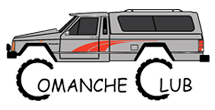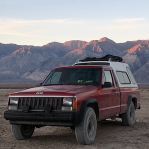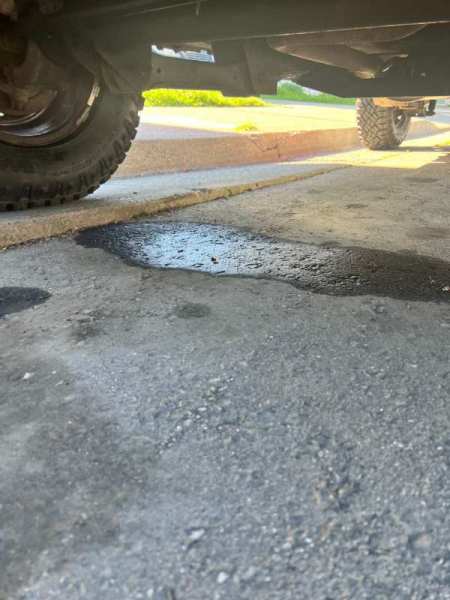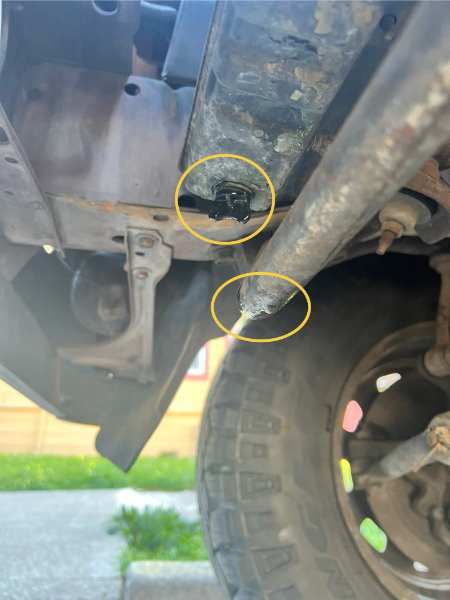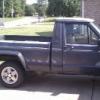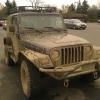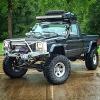Search the Community
Showing results for tags 'overheating'.
-
Update - Photos: I took some photos this morning in the daylight. I'm not sure if the liquid on the ground was from my MJ or something else. Hard to say. But it definitely looks to me like I'm getting some leakage around the base of the radiator. I've pasted them at the bottom of this post. I snapped these real quick on my way out to work. Will take a closer look after I get off. Some Background: If you have time, please read the whole post for all the details and then see my questions at the end. It took a while, but I finally got new tires on my MJ. I'd been driving on very old tires for way too long, and I was pretty sure they were causing the truck to shake at highway speeds. After getting the new tires installed (Good Year DuraTracs - 235/75/15), I was stoked to find that they significantly improved my drive on the freeway, and I drove about 30-40 miles at normal highway speeds for the first time in a long time. It felt great to be able to do that again, and I hope that I may finally be close to resolving my long battle with death wobble and not-so-deadly shimming. (If you've followed other posts of mine, you may remember that I had a lot of work done on the Jeep to fix the death wobble and that I'd made a lot of progress, but still needed to replace the tires). Anyway, that's not really what this post is about. The Overheating Issue: When I got off the freeway, I noticed that my heat gauge was redlining, so I pulled over. I popped the hood and saw that the coolant reservoir was boiling and that the cap on the reservoir is cracked. I let the truck cool off for a few hours and then drove back home (another 40 miles or so). It was probably around 80 degrees when I started driving earlier. By the time I drove home, it was night time and it was much cooler outside. I turned on the heat in the cab and made it all the way back home without any overheating issues or boiling (at least none that I could hear... I did not pop the hood when I got home, I just listened to see if I could hear any gurgling). My Theories So Far: The crack in the coolant reservoir cap concerns me, but I actually think that's been there for a long time. I have a 1987 2.5L, and my Haynes manual says that the overflow reservoir in these is not part of a pressurized system. But I'm no expert on this front. I have to do some more troubleshooting, but my first thought is that the water pump might be dying. The only other time I've encountered the boiling reservoir it was when my first water pump was shot. I replaced it probably 4 years ago now. Right before I noticed the overheating, I heard some engine noise that sounded similar to what it sounded like the last time the water pump went out. It was kinda like the sound of clanking metal being carried into the cab via tubes. It's not as pronounced as it was when I last changed the pump, but it definitely sounded similar. My Questions: Do you all think my water pump is going bad again? Do you think that's a good, low cost place to start? I drive the truck a fair amount, but it is not what I'd call a daily driver either. I have taken it on some pretty bumpy roads though since replacing the water pump and gone on some long road trips... so there's that. How vital is it to get a new reservoir cap for a 1987 2.5L? I definitely am planning to fix that ASAP, since it will be pretty cheap and I think relatively easy. Not trying to avoid it. Just wondering what my priorities should be. Is there any chance you think having the tires changed could have resulted in knocking something loose or shifting some fluid around or something? Like I said, this isn't exactly a daily driver, but I have made the trip I made today plenty of times over the past few years and sometimes on much hotter days. I wouldn't think the shop could have caused this, but I just am trying to understand why this happened today. I'm also wondering if driving it over 70 mph for the first time in a long time is why this cropped up today. Maybe the water pump has been going for a while and I just haven't pushed the truck hard enough in a while. Maybe the installation of power steering and new belts helped speed this problem along? When I got it worked on for Death Wobble, I also had power steering put in. And ever since then, there has been what I have assumed was belt noise. I tried a few simple things to resolve it, like tightening the belts, but I didn't ever get to the bottom of what was causing the noise. It wasn't a tell-tale screeching, but the noise would temporarily go away when I sprayed soapy water on the running belts, which made me think it was the belt. But maybe the soap was also lubing up the bearings in the water pump housing and thus stopping the noise temporarily? Finally, on a side note and in relation to the Death Wobble: How much jiggle is normal on a healthy MJ when driving on the freeway? I drove my truck for way too long with it's wobble issues before all the fixes (which I outlined in this comment). Now I'm a bit traumatized and I can't really remember what it was like before the wobble started presenting itself. I'm hoping that I start to get my trust back with time. Driving the truck today, after getting the new tires on, it felt soooo much better, but it still shakes when I hit a bump. I mean, obviously a 38 year old truck is going to shake when it hits a bump in the road, but I'm left wondering what is normal and what isn't... --- --- --- OK. I hope some of you will read this and respond to my questions. As always, any and all insights are appreciated, so thanks in advance!
- 4 replies
-
- water pump
- overheating
-
(and 3 more)
Tagged with:
-
Hello there, I have an 87’ mj 2.5L, having a serious problem with overheating. For the first two weeks i had it it was constantly overheating, then in one afternoon i put a new rad in, new thermostat, new filters, and an oil change. Immediately it solved the overheating issue. Been about a month now of smooth and perfect temp running, until it sat for a week then started overheating again. Before it was the radiator overheating, now it seems to be smoking out of the back of the engine block. I’m thinking it has something to do with the thermostat, if anyone has any ideas or solutions or want more information, please let me know!!! Thanks
- 2 replies
-
- overheating
- thermostat
-
(and 2 more)
Tagged with:
-
1990, with basically stock 4.0. Recently upgraded to Volvo 4 hole injectors. Runs great, better gas mileage. Most of my driving is sea level to 1000 feet. Went to Eastern Washington and crossed one pass at 5400 ft and into a back-country lake at 2200+ feet. On both I noticed a definite loss of power and overheating. The route into the lake was only 2200 to 4000 feet, but was done slowly on a rough, rocky road. The initial 1000 feet was very steep and overheated to boiling over. The pass was highway speeds, 60 mph, and overheated, but not to the red-line. Dropped off as soon as I started downhill and dropped rpm. I noticed a definite lack of power each time. I reset the ECM after adding the new injectors, and it's been running great, but wonder if I could be running lean, particularly at altitude. Reset ECM again, other suggestions??? Next step will be upgrading to a open (real radiator and cooling) system.
- 11 replies
-
- overheating
- higher altitude
-
(and 1 more)
Tagged with:
-
I hesitate to even begin another post about a Comanche overheating. I've read all the posts I can find here and elsewhere. The problem is that its still overheating. I will give you a little background and what I have tried, then post a couple of questions. This is an 88MJ, 4.0L, SWB 2WD. mileage - around 400,000 miles. It has about 15k miles on a rebuilt motor, and a new radiator was put in at the same time. I have done a pressure check on all cylinders and they are all around 140-150. It ran OK all spring, then started overheating as the weather warmed up this past summer. (Note: I bought this truck new, and have NEVER had an overheating problem). Crank it, 5 minutes later its boiling over. My first purchase was an OEM reservoir and OEM cap, since it was blowing the old one off. After a few more boil-overs, I removed and replaced the thermostat. I bought the one with the little valve in it, and I put the valve near 12 o'clock. I went with what was recommended for the vehicle - 185 or 190 degrees. (In the past I've used a 165 degree) I realized that my problem was probably trapped air, so I changed the thermostat cover out with a newer model one that had an opening for a sensor in the top. I put a valve in there. (I saw this somewhere, it wasn't my concoction). I parked it nose up, jacked it up a little to get more angle, and bled it from the front. Same result. Five minutes, and it was in the red. I now know the right way to do this. As I was working with it, the water pump started to make a little noise, so I replaced the water pump and the fan clutch. Until this point, when it got hot, it would leak from somewhere. I had to reposition and super-tighten all hoses, and it still drips a few drops under pressure, but not like it did. I saw a post where someone mentioned the heater valve. That was a new revelation. There was no vacuum hooked up to it, so I held it open with a zip tie, turned the HVAC to warm, fan off, put it nose down, and burped it. ran it, let it cool. repeat. I've done that 4 times now. I remove the sensor, air comes out, coolant comes out. reinstall sensor, run it, and now it takes about 7 minutes to get to about 235+, and here's the kicker. When cool, the reservoir is almost full. When I bleed the air out, the reservoir goes down to about 1 inch of fluid. After I run the cycle and let it cool, its at the same place it was before. There is no less air in the system after 4 times burping it. I havent had to add coolant. That confuses me, cause that means the air I burp out comes right back - do I just need to keep on doing this? So, here are my main questions: 1) Could the higher temp thermostat be the problem? or, rather, could a lower temp thermo help? 2) I plan on bypassing the heater valve, but until then, could that be the source of my problem? 3) When running it to burp it should the heat actually be blowing, or just in the warm position, fan off? 4) I looked at the metal reservoir method, the closed to open system change (with and without radiator replacement). I have the Moroso inline filler on order for the top radiator hose, but haven't figured out which reservoir would be best. Has anyone found one that fits well where the reservoir sits? Any tips? 5) My question here is how the heck does the open system work better? How does any fluid in the overflow get pulled back in the system if needed? I'd really like to be able to wrap my head around this. 6) What have I missed, or where did I go wrong? This almost has to be something "easy" that my ADD just skipped right over. Thanks in advance, guys.
- 23 replies
-
- Cooling system
- open system
-
(and 3 more)
Tagged with:
-
Hello, I have an 1988 jeep Comanche Eliminator used as a daily driver with an overheating brake problem. I just replaced the front disc with slotted rotors and new pads and also replaced the rear drum shoes to. The brakes work good until you go down hills. When going down hills I can start to feel the brakes fade and then the brake peddle goes to the floor with the truck slowly coming to a stop and I have to pull over because I have no brakes. Even when I pump the brakes that doesn't help ether. I don't ride my brakes and usually use engine braking. I was wondering if my master cylinder is going bad? The brake fluid is not that new but i'm going to bleed the brakes and put new fluid in. I heard that the brake boosters are bad in the 1988 jeeps? is that true or not? Any advise needed, Thanks.
-
My radiator got punctured (did not drive without coolant in it) and I replaced it, refilled it. Ive flushed my coolant several times before so I know how to do that. But now its running a little hot. Maybe 10-20 degrees. Nothing too terrible but I don't want to drive it like that. Any ideas would be greatly appreciated!
-
I have a 1988 renix mj with a 4.0, 103K with the closed loop system that was from Canada. It started to over heat on my in the city a month or so ago in the peak of summer about a month ago. I live in south texas so temps get up to 100-110 all summer. I wanted to eliminate all possibilities so I started to replace the WHOLE cooling system. One thing to mention. This truck did not come with ac from the factory and it did not come with the Electric fan from the factory also. Items Freshly installed: New zj Fan Clutch New CFS 3 row radiator new Flow Kooler water pump New High flow thermostat New themostat housing New upper and lower radiator hoses New Fan Shroud New Serp Belt. New sealed Overflow Tank New coolant I got it all hooked up and drove it for a bout 20 miles on the highway and a little in town and it did fine. Then I parked it and let it Idle. And this is what it did. Outside Temperature : 75 degrees Fahrenheit Time : 8:45 PM don't have a picture of when I parked it but it was sitting at the normal mark. Time : 9:05 pm Time elapsed : 20 mins Time: 9:15 pm Time elapsed : 30 mins Time : 9:25 pm Time elapsed : 40 mins Time : 9:35 pm Time elapsed : 50 mins Time : 9:45 pm Time elapsed : 60 mins I will say the temps do not climb nearly as fast as it did before I replaced everything but then again it was around 85-90 degrees when I did. Let me also note that like I said the truck was made in Canada that's why the temperatures are in Celsius. However I know the truck has been in Texas for at leased the last 10 years. Lastly, The Truck does not show any signs of head gasket failure. exhaust is VERY clean, no smoke, no water or coolant coming out of it, and it does not burn it. Please help me and tell me what to do now!!!!!
